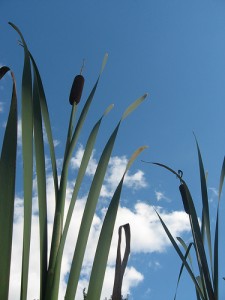You might have already known this, but I did not, and am intrigued to have found out: ethanol, the gasoline substitute that can help the U.S. achieve much-needed energy independence from the volatile Mideast, does not have to be made from corn, at all. That’s good news for two reasons: it takes huge fossil-fuel inputs to grow corn, and corn should be feeding people, not internal combustion engines. (Who’s in charge around here, anyway, people or machines?)
that can help the U.S. achieve much-needed energy independence from the volatile Mideast, does not have to be made from corn, at all. That’s good news for two reasons: it takes huge fossil-fuel inputs to grow corn, and corn should be feeding people, not internal combustion engines. (Who’s in charge around here, anyway, people or machines?)
But I digress. Here is what I’ve learned: Many plants yield much more ethanol per acre than corn, with cattails topping the list at 2,500 to 10,000 gallons/acre compared to corn’s yield of 214-392 gallons/acre. Cattails can even be grown in sewage, which environment actually creates their highest yield. I call that efficiency, given that our world has no shortage of sewage.
I learned all this Tuesday evening at a climate change forum in Eugene, Oregon, from Tim Thurkow, an engineer who is also a graduate of the University of Oregon’s Climate Masters program. Tim’s source is David Blume’s book on biofuels, “Alcohol Can Be A Gas”. The city of Eugene has a goal of reducing its greenhouse gas emissions 50% by 2030. I like that goal better than some cities’ goal of 80% reduction by 2050 because 2050 is too assumptive. Shorter-term goals give us the tighter focus that we need. Eugene’s leadership has my respect, and so does Joshua Skov of The Good Company, who kicked the evening off with an excellent presentation.
photo courtesy of herzogbr


 Subscribe
Subscribe
A nice thought, although I expect it would be difficult to find 1,000 square acres of sewage the way you can plant 1,000 square acres of corn. I also wonder what kind of planting and harvesting equipment could efficiently sludge through sewage. And I wonder how much damage to swamp ecosystems that machinery would do.
I’m a downer, though. I’m sure there are smart people who could find a way to get cat-tails to supply a limited amount of ethanol, just nothing close to the scale of corn.
Other sources of cellulosic ethanol seem more realistic: crop waste, switchgrass, wood waste, etc.
And don’t believe everything you hear about the food v. fuel debate. You’ve never eaten field corn in your life, I’d wager, and it’s a little known fact that ethanol production returns feed (distillers grains) back into the livestock system (1/3-1/2 of the corn nutrients).
Very cool! I love that they can grow in sewage. I think it would be a rather long-term solution, but I LOVE the mental image of our sewage processing facilities having cattail ponds. There really are lots of clever solutions out there, I believe, if only we apply our creativity and brains to the problems at hand.
Sounds good though I’d have concerns similar to those MM pointed out.
Right back to the food versus fuel problem. If you grow cattail in clean water and soil, it is one of the most productive food plants on the planet. The plant is also one of the main driving factors in desertification worldwide, and desperately needs control. Look at Africa’s Lake Chad! The cattail infestation there is what’s growing the Sahara! Here, cattail sloughs are a part of our dustbowl problem. In Australia they call it Cumbungi, and see it as a separate problem. Taming this plant as a resource is worthy of an enormous effort. Food, fuel and fiber are all to be had with exasperating renewability. Worldwide, this plant is on a march of conquest. And where it isn’t cattails, it’s water hyacinth or one of several other aquatic weeds. These are the shock army of the desert, and only our greed for food, fuel and fiber can control them. They all collect toxic chemicals, so some care must be used in their exploitation. Wherever we reduce them, we will improve our water supply. The silt they produce must be removed, too.
There are also some other really promising alternative biofuel crops, like silver maples, willows, and poplars. Those are fast growing trees that often thrive in soil not suitable for food crops. Plus, you only harvest them once every 5 years (or even longer), so you’re burning much less fuel per unit of biomass.
Even though we’ve been making ethanol for some time, we’ve still barely scratched its surface. Once we stop using the starch in corn and start using cellulose in other plants, we could see some real progress.
My thoughts on all this: LET’S GET GOING ON ALL THIS INNOVATION! Our government should be offering big fat loans to folks that want to experiment with and refine these new potential sources of fuel and the technology to harvest them — rather than bailing out the auto companies. And while the really-smart techies figure out biofuels, the rest of us can do our best to reduce our fuel-use and support public policies that encourage out-of-the-box solutions.
MM, Stephen, and Lou: the information you provided on cattails and other fuels is valuable — thank you. Colleen, my favorite part of your comment is that we all need to reduce our fuel-use. I notice that our culture in general gets much more excited about using different fuels than about using less fuels.
Even if cellulosic ethanol proves to be energy and cost effective, a huge hurdle in itself, there just isn’t enough area to harvest it from to continue anywhere near the gas guzzling we now engage in.
Even if hybrids became the standard, with better gas mileage, only around 10% of liquid fuel could come from cellulose, with every spare acre devoted to harvesting. And that would destroy conservation land.
The only way to get rid of oil guzzling is to go to plugin vehicles running on renewable energy and electric commuter rail. Plugin hybrids for the near term where miles driven between charges exceed battery storage capacity.
Biomass based gas guzzling of any kind? Fugedaboutit. Biodigestion of the waste stream with organic fertilizer and biogas energy production, that is the carbon negative way to use waste biomass.
Amazing, I don’t know where you’re getting your stats. Please provide a reference.
I suspect you’re making those up, since ethanol from corn is already in almost 10% of the fuel supply.
And this DOE study http://feedstockreview.ornl.gov/pdf/billion_ton_vision.pdf shows that there are more than one billion tons of biomass in the U.S., and it doesn’t include sensitive land, parks or areas with little to no road access. So I don’t know where your “destroy conservation land” comment is coming from.
Cellulose is a real solution, and we need to stop regurgitating misinformation on this subject. It’s not going to help our situation at all.
That said, I think hybrids are the answer, flex fuel hybrids, that is. But that poses the equally difficult dilemma of making our grid green, because face it: we do not get electricity from green sources today. So at the moment, battery power will do nothing more than aggregate pollution around power plants rather than on the roads.
Here’s an article I wrote at dailykos on this very subject.
It’s such a shame alternative energy companies are going bankrupt while ExxonMobil complains they only made $8 Billion in PROFIT this quarter.
http://www.dailykos.com/story/2008/8/15/184751/696/924/568614
This short video will reveal a surprising secret you’re friends will be impressed you know.
The First Flex-Fuel Vehicle: (5:34)
http://alcoholcanbeagas.com/node/1331
Офигенно! Спасибо!!!
How to save the world … | The Bat Country Word // Feb 17, 2012 at 10:30 am
[...] There are other things you can do with a small amount of land. Did you know you can get about 7,500 gallons of ethanol from an acre of cattails. (Yes, those weeds that look like corndogs.) That’s a lot of gas for cooking, or steam engines, [...]
I love it when someone technically uneducated writes about engineering. This lady does not know what she is talking about.
Augustine, I’d appreciate better information on this topic, if you have some. I’m sending you an email right now asking for that. This post has gotten many views, and I want to be giving accurate information.